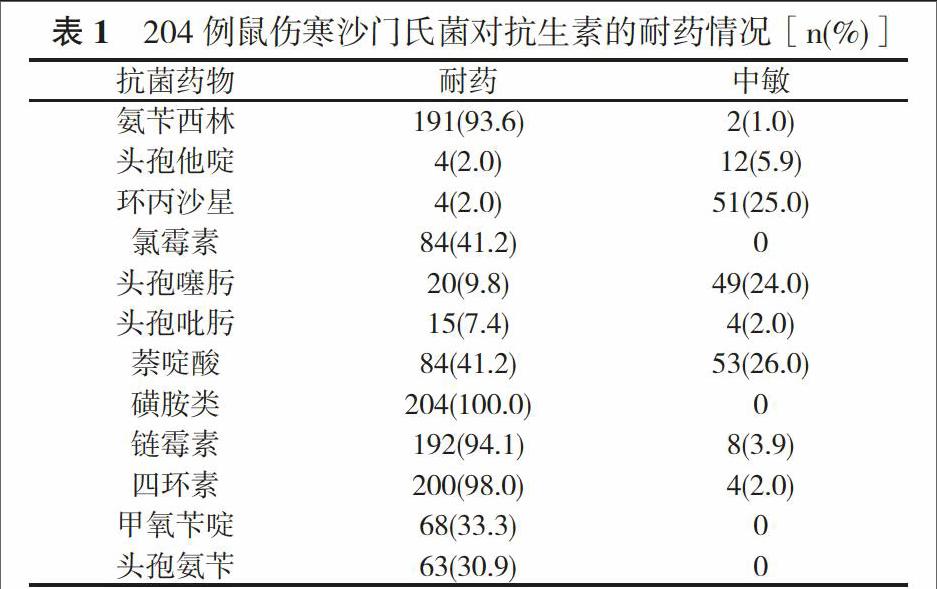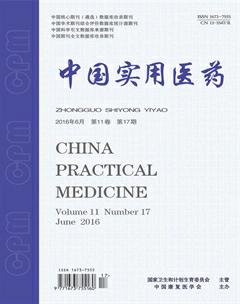204例儿童感染鼠伤寒沙门氏菌临床分析
梁燕霞 李小南 伍绍东

【摘要】 目的 回顾分析临床儿童感染鼠伤寒沙门氏菌耐药情况, 指导临床合理用药。方法 420例沙门氏菌腹泻儿童, 从其粪便中分离沙门氏菌, 采用血清学凝集试验确定沙门氏菌血清型, 再采用Kerby-Bauer纸片扩散法检测其对抗菌药物的敏感性。结果 从腹泻儿童粪便分离出420例沙门氏菌中, 鼠伤寒沙门氏菌204例, 占48.57%。鼠伤寒沙门氏菌对多种抗生素产生耐药, 对磺胺类药全部耐药(100.0%), 耐药率较高的还有氨苄西林(93.6%), 链霉素(94.1%), 四环素(98.0%);耐药率最低的是头孢他啶(2.0%), 环丙沙星(2.0%), 其余出现不同程度的耐药性。结论 鼠伤寒沙门氏菌对多种抗生素产生耐药性, 并出现多重耐药性, 临床上需根据药敏结果合理使用抗生素。
【关键词】 沙门氏菌;鼠伤寒;耐药性
DOI:10.14163/j.cnki.11-5547/r.2016.17.022
Clinical analysis of 204 children infected by mouse typhus salmonella LIANG Yan-xia, LI Xiao-nan, WU Shao-dong. Department of Inspection, Zhuhai Maternal and Child Health Care Hospital, Zhuhai 519000, China
【Abstract】 Objective To retrospectively analyze drug resistance of children infected mouse typhus salmonella, and to guide rational clinical drug use. Methods Salmonella from 420 children with salmonella diarrhea were separated from faeces, and their serum type was confirmed by serology agglutination test. Kerby-Bauer disk diffusion test was used to detect sensitivity to antibacterial agents. Results Among 420 separated salmonella from faeces, there were 204 mouse typhus salmonella cases, accounting for 48.57%, which was resistant to multiple antibiotics. It showed complete resistance to sulfonamides (100.0%), followed by ampicillin (93.6%), streptomycin (94.1%) and tetracycline (98.0%) with high resistance rates. Ceftazidime (2.0%) and ciprofloxacin (2.0%) had the lowest resistance rates, and others showed various resistance. Conclusion Mouse typhus salmonella shows resistance for various antibiotics, along with multi-drug resistance. Rational application of antibiotics is necessary in accordance with drug sensitivity outcomes.
【Key words】 Salmonella; Mouse typhus; Drug resistance
鼠伤寒沙门氏菌是一群非适应性或泛嗜性的沙门氏菌, 具有广泛的宿主, 是目前世界各国分离率最高的菌型之一。主要以儿童感染为主。本文分析儿童感染鼠伤寒沙门氏菌的耐药情况, 现报告如下。
1 资料与方法
1. 1 一般资料 选取2014年1月~2015年12月本院沙门氏菌腹泻儿童420例。
1. 2 方法 在无菌条件下将采集标本接种在四硫磺酸钠肉汤中, 37℃, 24 h增菌后, 分别接种在伊红美蓝和S.S培养基中, 37℃, 培养24 h, 挑选可疑菌落做革兰染色, 双糖铁及纯培养之后进行生化反应及血清学鉴定。
2 结果
420例沙门氏菌中, 鼠伤寒沙门氏菌204例, 占48.57%。本组204例鼠伤寒沙门氏菌, 对磺胺类药全部耐药, 耐药率较高的还有氨苄西林(93.6%), 链霉素(94.1%), 四环素(98.0%);耐药率最低的是头孢他啶(2.0%), 环丙沙星(2.0%), 其余出现不同程度的耐药性。见表1。
3 讨论
鼠伤寒沙门氏菌是小儿腹泻的常见致病菌之一, 多通过不洁喂养或不卫生饮食而感染婴幼儿, 临床多表现为胃肠炎型。一年四季均可发生, 本文中8~11月份发病率较高。
鼠伤寒沙门氏菌是引起小儿肠道感染最常见致病血清型, 而抗菌药物是治疗鼠伤寒沙门氏菌引起的肠道感染必不可少的手段, 但不少沙门氏菌已对多种抗生素产生耐药性, 并出现多重耐药性, 尤其是鼠伤寒沙门氏菌。其中第三代头孢菌素有着独特的药效学和较低的耐药率[1, 2], 因而是用于治疗沙门氏菌侵袭性感染和严重腹泻最常用的药物。而耐头孢菌素伤寒沙门氏菌的出现及数量的增加已经引起全世界的关注, 因该菌极易产生耐药性, 使抗菌药物疗效较差, 病程迁延不愈, 成为临床治疗的难点。
肠炎沙门氏菌是亚、欧、拉美地区最常见的血清型[3]。鼠伤寒菌感染抗菌药物治疗对于肺炎型、肠热症型和败血症型均应给予强有力的抗菌药物治疗[4-6]。一般认为鼠伤寒肠炎为自限性疾病, 抗生素疗效不但不佳, 反而使沙门氏菌摆脱竞争和对抗作用, 延长排菌期, 耐药菌大为增加, 因此, 应对新生儿、体弱儿或重症者选择适当的抗生素治疗[7]。
鼠伤寒沙门氏菌对多种抗生素产生耐药性, 并出现多重耐药性。临床应提高对鼠伤寒菌耐药性严重程度的认识, 认真分析原因, 给予相应处理。在无药敏参考情况下盲目选药造成一定的药品浪费, 增加医疗费用, 且患儿因病程迁延, 严重影响患儿生长发育, 临床上需根据药敏结果合理使用抗生素。
参考文献
[1] Archambault M, Petrov P, Hendriksen RS, et al. Molecular characterization and occurrence of extended-spectrum beta-lactamase resistance genes among Salmonella enterica serovar Corvallis from Thailand, Bulgaria, and Denmark. Microb Drug Resist, 2006, 12(3):192-198.
[2] Batchelor M, Hopkins K, Threlfall EJ, et al. bla(CTX-M) genes in clinical Salmonella isolates recovered from humans in England and Wales from 1992 to 2003. Antimicrob Agents Chemother, 2005, 49(4):1319-1322.
[3] Herikstad H, Motarjemi Y, Tauxe RV. Salmonella surveillance: a global survey of public health serotyping. Epidemiol Infect, 2002, 129(1):1-8.
[4] 李梦东.实用传染病学.第2版.北京:人民卫生出版社, 1998: 389.
[5] 田庚善, 贾辅忠.临床感染病学.南京:江苏科技出版社, 1998: 360.
[6] 翁新华, 潘孝彰, 王岱明.现代感染病学.上海:上海医科大学出版社, 1998:381.
[7] 邹晓红, 项曙光, 韩红芬.小儿鼠伤寒沙门氏菌感染32例临床分析.临床儿科杂志, 2000, 18(3):21-23.
[收稿日期:2016-02-22]

